Question
Read above case study and answer below questions: a) Discuss the TexRob approach to continuous improvement. What conditions must be met before improvement can take
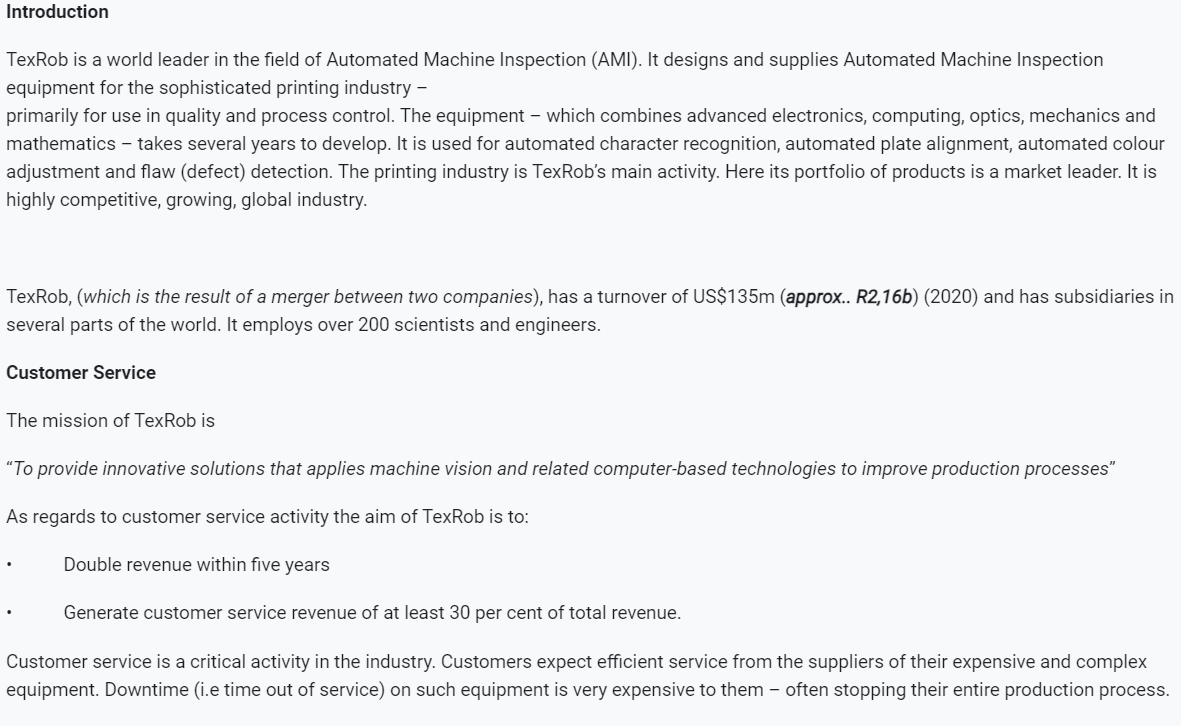
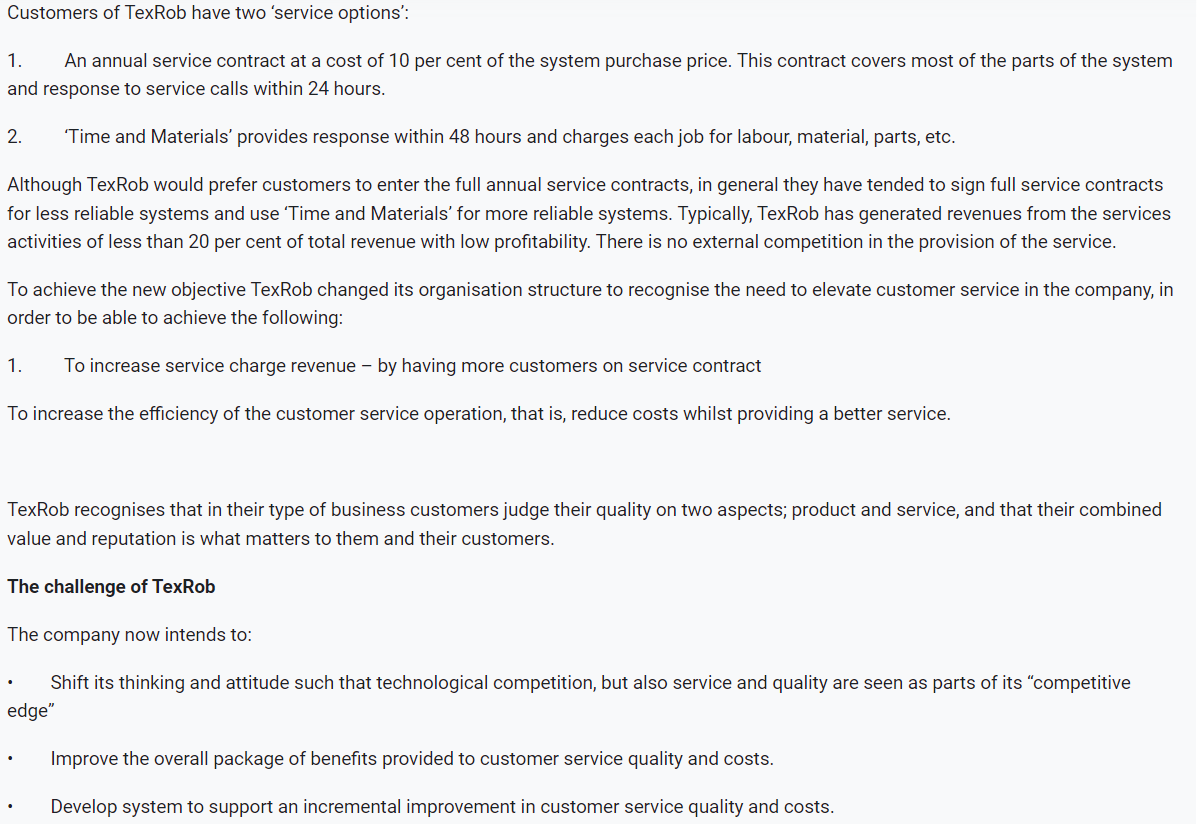
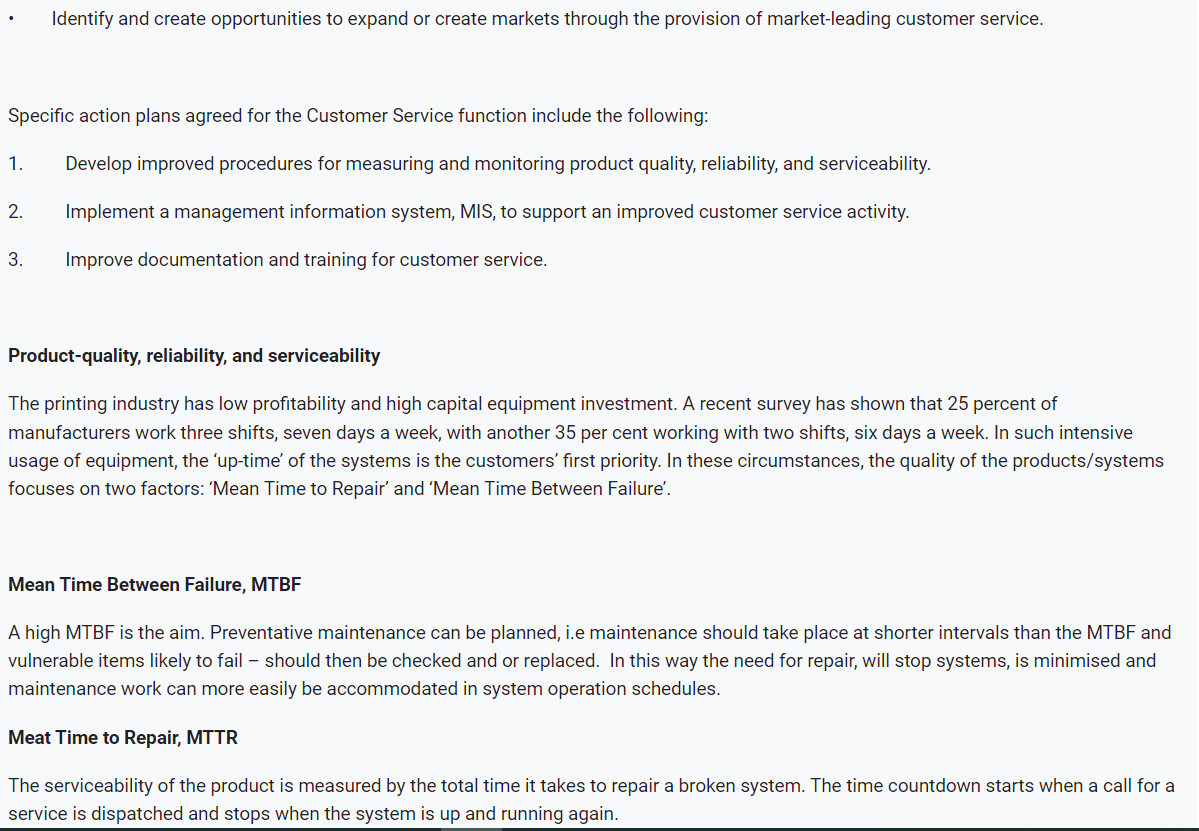
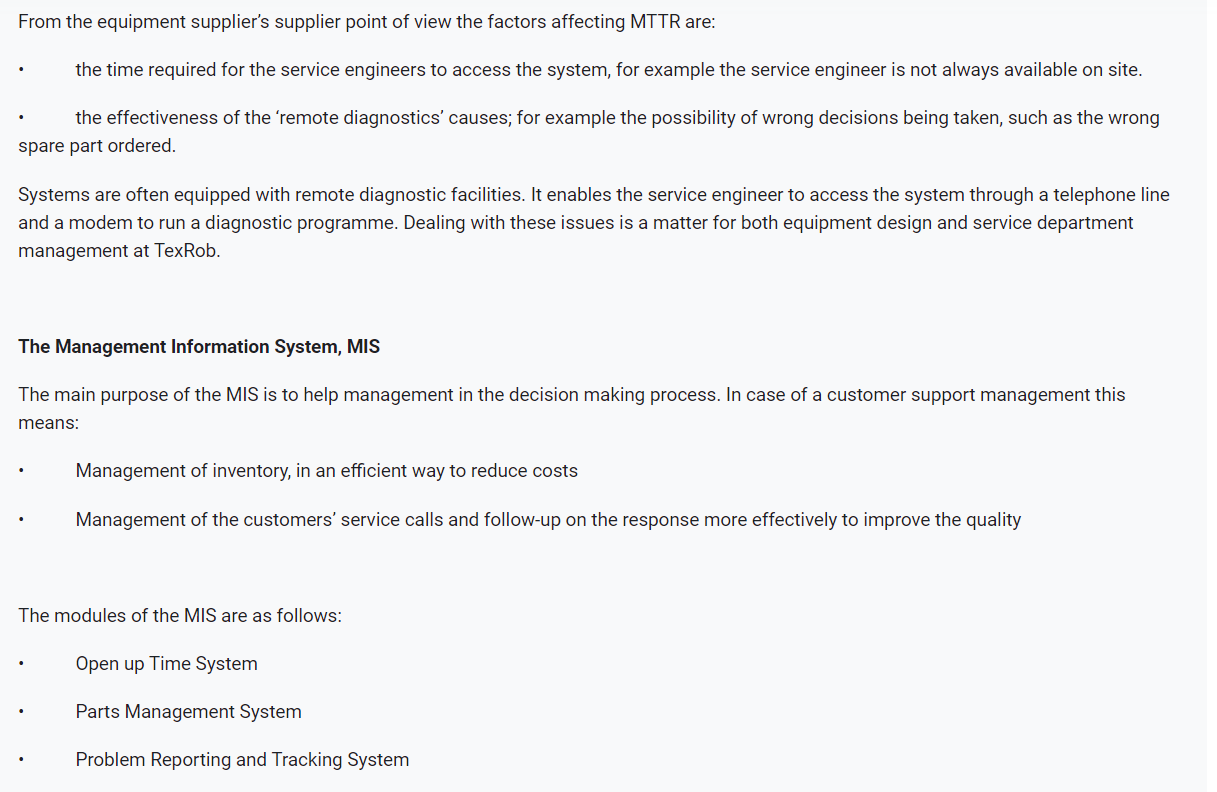
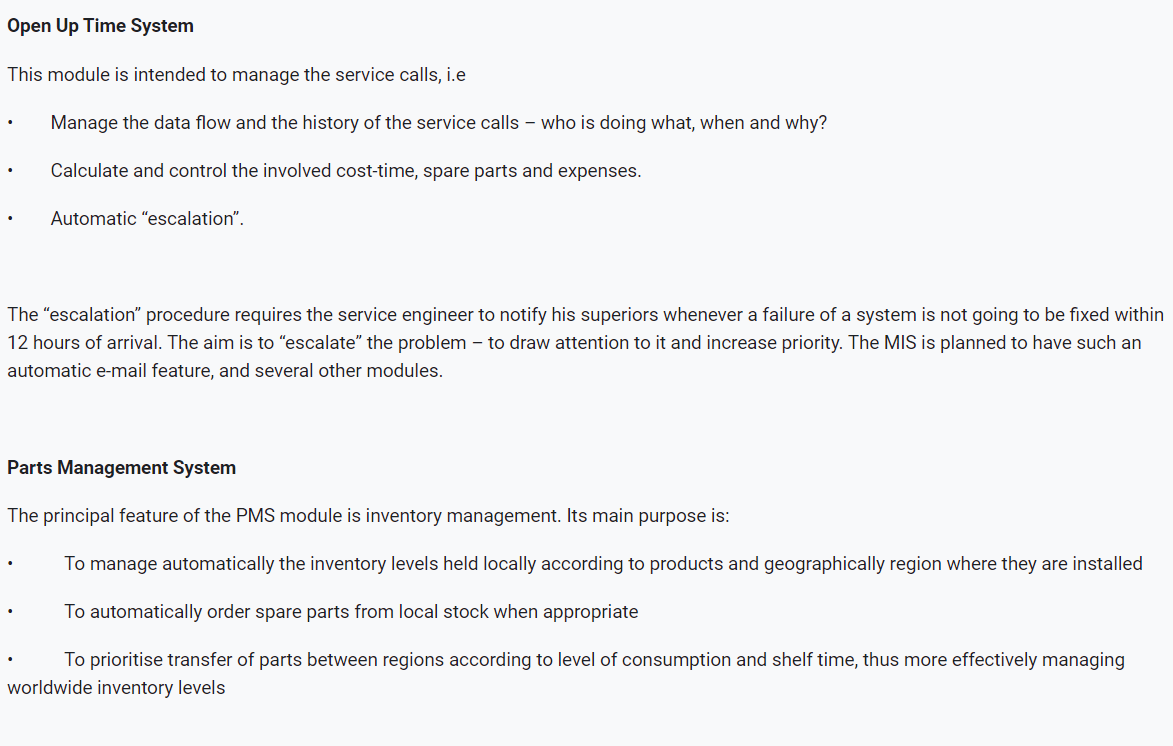
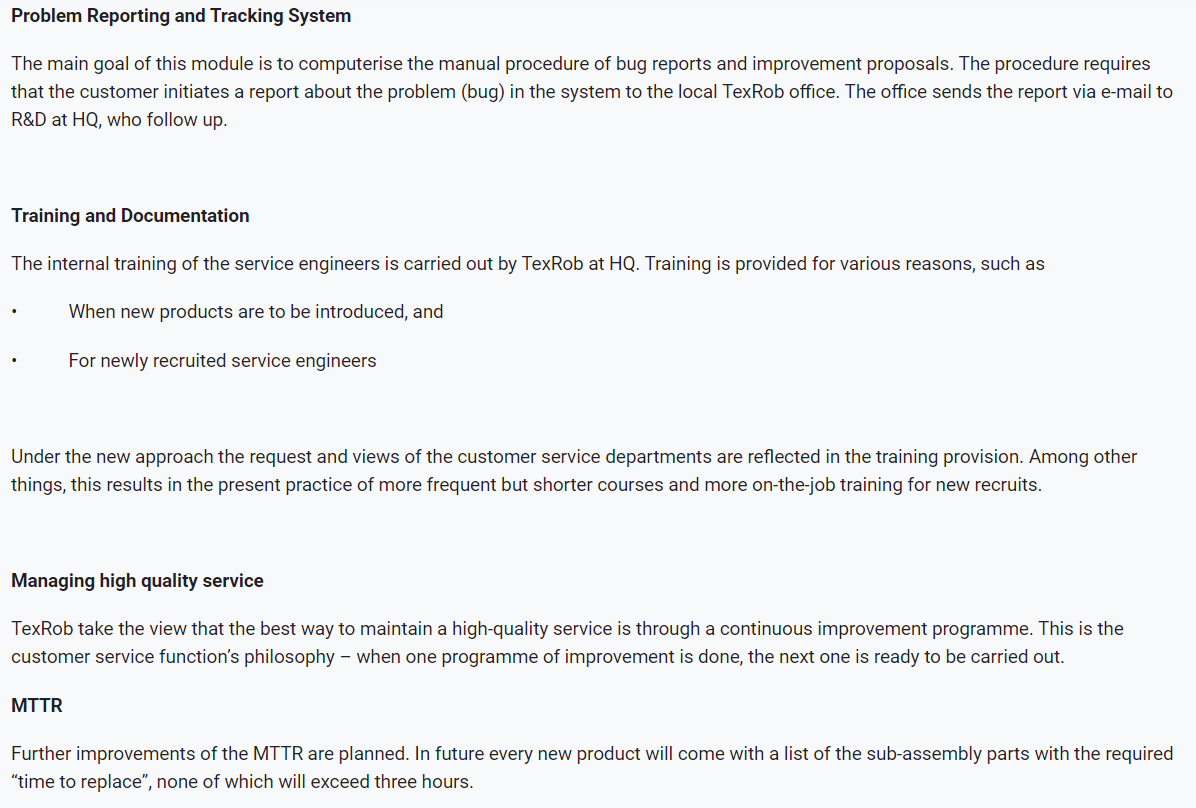
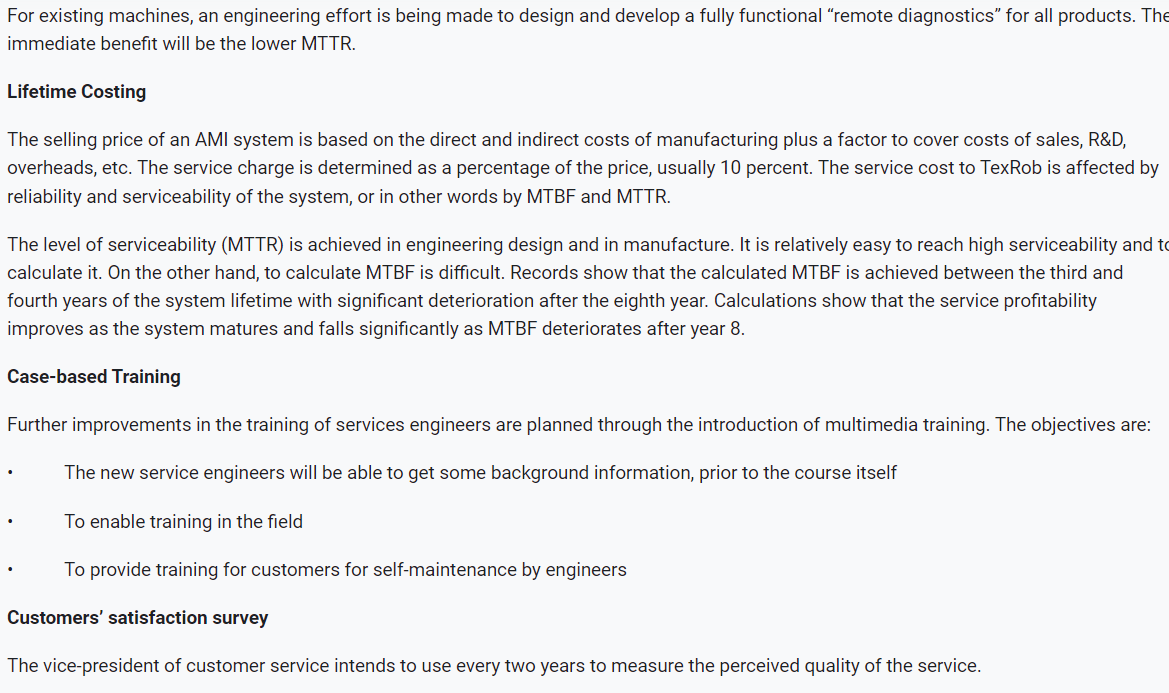
Read above case study and answer below questions:
a) Discuss the TexRob approach to continuous improvement. What conditions must be met before improvement can take place?
b) What are the risks for TexRob, and what plans need to be put in place to ensure that their own technology and systems are consistently reliable?
c) What are the risks for a potential customer especially with regard to ensuring that an operation can continue to function at capacity and how the customer manages these risks?
d) What are the factors that a customer has to take into account to determine the total cost of ownership? Please note that all of the factors will be valid for each option. Give an example for each of the factors.
e) Based on the above case study, kindly provide an introduction.
f) Identify and discuss problems and issues based on the case study.
g) The application of theory and integration.
h) Discuss the recommendations.
i) Discuss the decisions and solutions.
j) Provide the conclusion.
Problem Reporting and Tracking System The main goal of this module is to computerise the manual procedure of bug reports and improvement proposals. The procedure requires that the customer initiates a report about the problem (bug) in the system to the local TexRob office. The office sends the report via e-mail to R&D at HQ, who follow up. Training and Documentation The internal training of the service engineers is carried out by TexRob at HQ. Training is provided for various reasons, such as When new products are to be introduced, and For newly recruited service engineers Under the new approach the request and views of the customer service departments are reflected in the training provision. Among other things, this results in the present practice of more frequent but shorter courses and more on-the-job training for new recruits. Managing high quality service TexRob take the view that the best way to maintain a high-quality service is through a continuous improvement programme. This is the customer service function's philosophy - when one programme of improvement is done, the next one is ready to be carried out. MTTR Further improvements of the MTTR are planned. In future every new product will come with a list of the sub-assembly parts with the required "time to replace", none of which will exceed three hours. Customers of TexRob have two 'service options': 1. An annual service contract at a cost of 10 per cent of the system purchase price. This contract covers most of the parts of the system and response to service calls within 24 hours. 2. 'Time and Materials' provides response within 48 hours and charges each job for labour, material, parts, etc. Although TexRob would prefer customers to enter the full annual service contracts, in general they have tended to sign full service contracts for less reliable systems and use 'Time and Materials' for more reliable systems. Typically, TexRob has generated revenues from the services activities of less than 20 per cent of total revenue with low profitability. There is no external competition in the provision of the service. To achieve the new objective TexRob changed its organisation structure to recognise the need to elevate customer service in the company, in order to be able to achieve the following: 1. To increase service charge revenue - by having more customers on service contract To increase the efficiency of the customer service operation, that is, reduce costs whilst providing a better service. TexRob recognises that in their type of business customers judge their quality on two aspects; product and service, and that their combined value and reputation is what matters to them and their customers. The challenge of TexRob The company now intends to: - Shift its thinking and attitude such that technological competition, but also service and quality are seen as parts of its "competitive edge" 2 - Improve the overall package of benefits provided to customer service quality and costs. Develop system to support an incremental improvement in customer service quality and costs. For existing machines, an engineering effort is being made to design and develop a fully functional "remote diagnostics" for all products. The immediate benefit will be the lower MTTR. Lifetime Costing The selling price of an AMI system is based on the direct and indirect costs of manufacturing plus a factor to cover costs of sales, R\&D, overheads, etc. The service charge is determined as a percentage of the price, usually 10 percent. The service cost to TexRob is affected by reliability and serviceability of the system, or in other words by MTBF and MTTR. The level of serviceability (MTTR) is achieved in engineering design and in manufacture. It is relatively easy to reach high serviceability and t calculate it. On the other hand, to calculate MTBF is difficult. Records show that the calculated MTBF is achieved between the third and fourth years of the system lifetime with significant deterioration after the eighth year. Calculations show that the service profitability improves as the system matures and falls significantly as MTBF deteriorates after year 8. Case-based Training Further improvements in the training of services engineers are planned through the introduction of multimedia training. The objectives are: The new service engineers will be able to get some background information, prior to the course itself To enable training in the field To provide training for customers for self-maintenance by engineers Customers' satisfaction survey The vice-president of customer service intends to use every two years to measure the perceived quality of the service. Open Up Time System This module is intended to manage the service calls, i.e - Manage the data flow and the history of the service calls - who is doing what, when and why? - Calculate and control the involved cost-time, spare parts and expenses. - Automatic "escalation". The "escalation" procedure requires the service engineer to notify his superiors whenever a failure of a system is not going to be fixed within 12 hours of arrival. The aim is to "escalate" the problem - to draw attention to it and increase priority. The MIS is planned to have such an automatic e-mail feature, and several other modules. Parts Management System The principal feature of the PMS module is inventory management. Its main purpose is: To manage automatically the inventory levels held locally according to products and geographically region where they are installed From the equipment supplier's supplier point of view the factors affecting MTTR are: the time required for the service engineers to access the system, for example the service engineer is not always available on site. the effectiveness of the 'remote diagnostics' causes; for example the possibility of wrong decisions being taken, such as the wrong spare part ordered. Systems are often equipped with remote diagnostic facilities. It enables the service engineer to access the system through a telephone line and a modem to run a diagnostic programme. Dealing with these issues is a matter for both equipment design and service department management at TexRob. The Management Information System, MIS The main purpose of the MIS is to help management in the decision making process. In case of a customer support management this means: Management of inventory, in an efficient way to reduce costs Management of the customers' service calls and follow-up on the response more effectively to improve the quality TexRob is a world leader in the field of Automated Machine Inspection (AMI). It designs and supplies Automated Machine Inspection equipment for the sophisticated printing industry - primarily for use in quality and process control. The equipment - which combines advanced electronics, computing, optics, mechanics and mathematics - takes several years to develop. It is used for automated character recognition, automated plate alignment, automated colour adjustment and flaw (defect) detection. The printing industry is TexRob's main activity. Here its portfolio of products is a market leader. It is highly competitive, growing, global industry. TexRob, (which is the result of a merger between two companies), has a turnover of US\$135m (approx.. R2,16b) (2020) and has subsidiaries in several parts of the world. It employs over 200 scientists and engineers. Customer Service The mission of TexRob is "To provide innovative solutions that applies machine vision and related computer-based technologies to improve production processes" As regards to customer service activity the aim of TexRob is to: Double revenue within five years Generate customer service revenue of at least 30 per cent of total revenue. Customer service is a critical activity in the industry. Customers expect efficient service from the suppliers of their expensive and complex equipment. Downtime (i.e time out of service) on such equipment is very expensive to them - often stopping their entire production process. - Identify and create opportunities to expand or create markets through the provision of market-leading customer service. Specific action plans agreed for the Customer Service function include the following: 1. Develop improved procedures for measuring and monitoring product quality, reliability, and serviceability. 2. Implement a management information system, MIS, to support an improved customer service activity. 3. Improve documentation and training for customer service. Product-quality, reliability, and serviceability The printing industry has low profitability and high capital equipment investment. A recent survey has shown that 25 percent of manufacturers work three shifts, seven days a week, with another 35 per cent working with two shifts, six days a week. In such intensive usage of equipment, the 'up-time' of the systems is the customers' first priority. In these circumstances, the quality of the products/systems focuses on two factors: 'Mean Time to Repair' and 'Mean Time Between Failure'. Mean Time Between Failure, MTBF A high MTBF is the aim. Preventative maintenance can be planned, i.e maintenance should take place at shorter intervals than the MTBF and vulnerable items likely to fail - should then be checked and or replaced. In this way the need for repair, will stop systems, is minimised and maintenance work can more easily be accommodated in system operation schedules. Meat Time to Repair, MTTR The serviceability of the product is measured by the total time it takes to repair a broken system. The time countdown starts when a call for a service is dispatched and stops when the system is up and running again. Problem Reporting and Tracking System The main goal of this module is to computerise the manual procedure of bug reports and improvement proposals. The procedure requires that the customer initiates a report about the problem (bug) in the system to the local TexRob office. The office sends the report via e-mail to R&D at HQ, who follow up. Training and Documentation The internal training of the service engineers is carried out by TexRob at HQ. Training is provided for various reasons, such as When new products are to be introduced, and For newly recruited service engineers Under the new approach the request and views of the customer service departments are reflected in the training provision. Among other things, this results in the present practice of more frequent but shorter courses and more on-the-job training for new recruits. Managing high quality service TexRob take the view that the best way to maintain a high-quality service is through a continuous improvement programme. This is the customer service function's philosophy - when one programme of improvement is done, the next one is ready to be carried out. MTTR Further improvements of the MTTR are planned. In future every new product will come with a list of the sub-assembly parts with the required "time to replace", none of which will exceed three hours. Customers of TexRob have two 'service options': 1. An annual service contract at a cost of 10 per cent of the system purchase price. This contract covers most of the parts of the system and response to service calls within 24 hours. 2. 'Time and Materials' provides response within 48 hours and charges each job for labour, material, parts, etc. Although TexRob would prefer customers to enter the full annual service contracts, in general they have tended to sign full service contracts for less reliable systems and use 'Time and Materials' for more reliable systems. Typically, TexRob has generated revenues from the services activities of less than 20 per cent of total revenue with low profitability. There is no external competition in the provision of the service. To achieve the new objective TexRob changed its organisation structure to recognise the need to elevate customer service in the company, in order to be able to achieve the following: 1. To increase service charge revenue - by having more customers on service contract To increase the efficiency of the customer service operation, that is, reduce costs whilst providing a better service. TexRob recognises that in their type of business customers judge their quality on two aspects; product and service, and that their combined value and reputation is what matters to them and their customers. The challenge of TexRob The company now intends to: - Shift its thinking and attitude such that technological competition, but also service and quality are seen as parts of its "competitive edge" 2 - Improve the overall package of benefits provided to customer service quality and costs. Develop system to support an incremental improvement in customer service quality and costs. For existing machines, an engineering effort is being made to design and develop a fully functional "remote diagnostics" for all products. The immediate benefit will be the lower MTTR. Lifetime Costing The selling price of an AMI system is based on the direct and indirect costs of manufacturing plus a factor to cover costs of sales, R\&D, overheads, etc. The service charge is determined as a percentage of the price, usually 10 percent. The service cost to TexRob is affected by reliability and serviceability of the system, or in other words by MTBF and MTTR. The level of serviceability (MTTR) is achieved in engineering design and in manufacture. It is relatively easy to reach high serviceability and t calculate it. On the other hand, to calculate MTBF is difficult. Records show that the calculated MTBF is achieved between the third and fourth years of the system lifetime with significant deterioration after the eighth year. Calculations show that the service profitability improves as the system matures and falls significantly as MTBF deteriorates after year 8. Case-based Training Further improvements in the training of services engineers are planned through the introduction of multimedia training. The objectives are: The new service engineers will be able to get some background information, prior to the course itself To enable training in the field To provide training for customers for self-maintenance by engineers Customers' satisfaction survey The vice-president of customer service intends to use every two years to measure the perceived quality of the service. Open Up Time System This module is intended to manage the service calls, i.e - Manage the data flow and the history of the service calls - who is doing what, when and why? - Calculate and control the involved cost-time, spare parts and expenses. - Automatic "escalation". The "escalation" procedure requires the service engineer to notify his superiors whenever a failure of a system is not going to be fixed within 12 hours of arrival. The aim is to "escalate" the problem - to draw attention to it and increase priority. The MIS is planned to have such an automatic e-mail feature, and several other modules. Parts Management System The principal feature of the PMS module is inventory management. Its main purpose is: To manage automatically the inventory levels held locally according to products and geographically region where they are installed From the equipment supplier's supplier point of view the factors affecting MTTR are: the time required for the service engineers to access the system, for example the service engineer is not always available on site. the effectiveness of the 'remote diagnostics' causes; for example the possibility of wrong decisions being taken, such as the wrong spare part ordered. Systems are often equipped with remote diagnostic facilities. It enables the service engineer to access the system through a telephone line and a modem to run a diagnostic programme. Dealing with these issues is a matter for both equipment design and service department management at TexRob. The Management Information System, MIS The main purpose of the MIS is to help management in the decision making process. In case of a customer support management this means: Management of inventory, in an efficient way to reduce costs Management of the customers' service calls and follow-up on the response more effectively to improve the quality TexRob is a world leader in the field of Automated Machine Inspection (AMI). It designs and supplies Automated Machine Inspection equipment for the sophisticated printing industry - primarily for use in quality and process control. The equipment - which combines advanced electronics, computing, optics, mechanics and mathematics - takes several years to develop. It is used for automated character recognition, automated plate alignment, automated colour adjustment and flaw (defect) detection. The printing industry is TexRob's main activity. Here its portfolio of products is a market leader. It is highly competitive, growing, global industry. TexRob, (which is the result of a merger between two companies), has a turnover of US\$135m (approx.. R2,16b) (2020) and has subsidiaries in several parts of the world. It employs over 200 scientists and engineers. Customer Service The mission of TexRob is "To provide innovative solutions that applies machine vision and related computer-based technologies to improve production processes" As regards to customer service activity the aim of TexRob is to: Double revenue within five years Generate customer service revenue of at least 30 per cent of total revenue. Customer service is a critical activity in the industry. Customers expect efficient service from the suppliers of their expensive and complex equipment. Downtime (i.e time out of service) on such equipment is very expensive to them - often stopping their entire production process. - Identify and create opportunities to expand or create markets through the provision of market-leading customer service. Specific action plans agreed for the Customer Service function include the following: 1. Develop improved procedures for measuring and monitoring product quality, reliability, and serviceability. 2. Implement a management information system, MIS, to support an improved customer service activity. 3. Improve documentation and training for customer service. Product-quality, reliability, and serviceability The printing industry has low profitability and high capital equipment investment. A recent survey has shown that 25 percent of manufacturers work three shifts, seven days a week, with another 35 per cent working with two shifts, six days a week. In such intensive usage of equipment, the 'up-time' of the systems is the customers' first priority. In these circumstances, the quality of the products/systems focuses on two factors: 'Mean Time to Repair' and 'Mean Time Between Failure'. Mean Time Between Failure, MTBF A high MTBF is the aim. Preventative maintenance can be planned, i.e maintenance should take place at shorter intervals than the MTBF and vulnerable items likely to fail - should then be checked and or replaced. In this way the need for repair, will stop systems, is minimised and maintenance work can more easily be accommodated in system operation schedules. Meat Time to Repair, MTTR The serviceability of the product is measured by the total time it takes to repair a broken system. The time countdown starts when a call for a service is dispatched and stops when the system is up and running againStep by Step Solution
There are 3 Steps involved in it
Step: 1

Get Instant Access to Expert-Tailored Solutions
See step-by-step solutions with expert insights and AI powered tools for academic success
Step: 2

Step: 3

Ace Your Homework with AI
Get the answers you need in no time with our AI-driven, step-by-step assistance
Get Started


